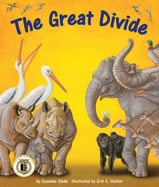Alignment to Standards for TX

| Grade | Number | Standard |
|---|---|---|
| 1 | 111.13 (1.1) | uses whole numbers to describe and compare quantities. |
| 1 | 111.13 (1.2) (B) | is expected to use appropriate language to describe part of a set such as three out of the eight crayons are red. |
| 1 | 111.13 (1.5) | recognizes patterns in numbers and operations. |
| 1 | 111.13 (1.5) (C) | is expected to compare and order whole numbers using place value. |
| 1 | 113.3. (1.5) | The student understands the purpose of maps and globes. |
| 2 | 111.14 (2.4) | models multiplication and division. |
| 2 | 111.14 (2.4) (A) | is expected to model, create, and describe multiplication situations in which equivalent sets of concrete objects are joined. |
| 2 | 111.14 (2.4) (B) | is expected to model, create, and describe division situations in which a set of concrete objects is separated into equivalent sets. |
| 2 | 113.4. (2.5) | uses simple geographic tools such as maps, globes, and photographs. |
| 2 | 113.4. (2.5) (A) | use symbols, find locations, and determine directions on maps and globes; and |
| 3 | 111.15 (3.4) | recognizes and solves problems in multiplication and division situations. |
| 3 | 111.15 (3.4) (A) | is expected to learn and apply multiplication facts through 12 by 12 using concrete models and objects. |
| 3 | 111.15 (3.4) (B) | is expected to solve and record multiplication problems (up to two digits times one digit). |
| 3 | 111.15 (3.6) (B) | is expected to identify patterns in multiplication facts using concrete objects, pictorial models, or technology. |
| 3 | 111.15 (3.6) (C) | is expected to identify patterns in related multiplication and division sentences (fact families) such as 2 x 3 = 6, 3 x 2 = 6, 6 / 2 = 3, 6 / 3 = 2. |
| 3 | 111.15 (3.7) (A) | is expected to generate a table of paired numbers based on a real-life situation such as insects and legs. |
| 4 | 111.16 (4.4) (B) | is expected to represent multiplication and division situations in picture, word, and number form. |
| 4 | 111.16 (4.6) | uses patterns in multiplication and division. |
| 4 | 111.16 (4.6) (A) | is expected to use patterns and relationships to develop strategies to remember basic multiplication and division facts (such as the patterns in related multiplication and division number sentences (fact families) such as 9 x 9 = 81 and 81 / 9 = 9). |
| K | 111.12 (K.1) | uses numbers to name quantities. |
| K | 111.12 (K.1) (A) | is expected to use one-to-one correspondence and language such as more than, same number as, or two less than to describe relative sizes of sets of concrete objects. |
| K | 113.2. (K.16) (B) | create and interpret visuals including pictures and maps. |
| PK | PK.1. (B) | counts by ones to 10 or higher |
| PK | PK.1. (C) | counts concrete objects to five or higher |
| PK | PK.1. (D) | begins to compare the numbers of concrete objects using language (e.g., ''same'' or ''equal,'' ''one more,'' ''more than,'' or ''less than'') |
| PK | PK.1. (E) | begins to name ''how many'' are in a group of up to three (or more) objects without counting (e.g., recognizing two or three crayons in a box) |